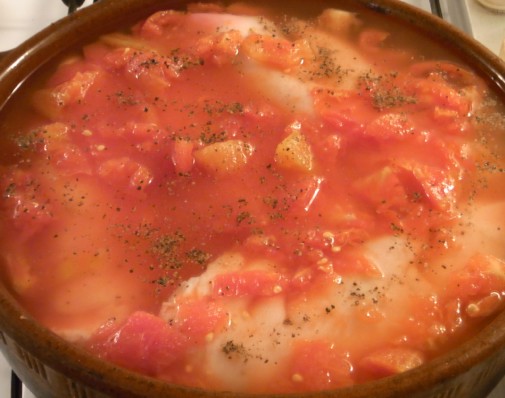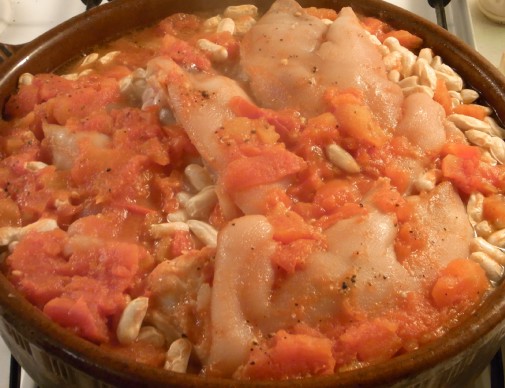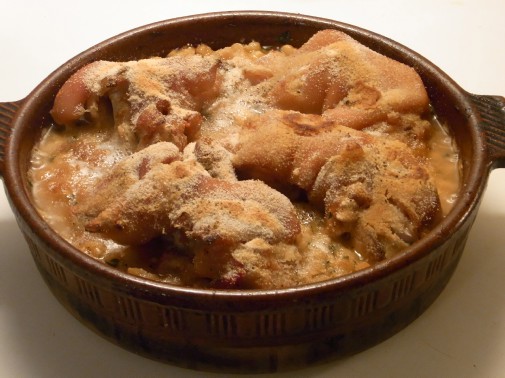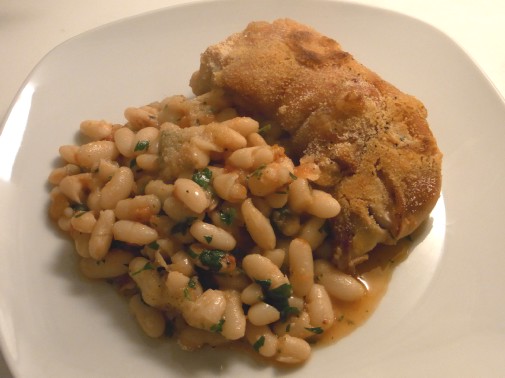Pigs’ feet with white beans
Pigs are very prominent in Spanish and Catalan cuisine. The loin stuffs many cafe sandwiches in the form of lomo or llom, other meats and innards become sausages such as the Catalan butifarras and many varieties of embutits, those types of cured meats and sausages such as chorizo, fuet and saltxitxa. The blood becomes morcilla sausages, often also filled with onions, spices, cinnamon or rice and a distinctly different version of our native black pudding. And of course, let’s not forget those magnificent jamons, those legs of pork waiting to be sliced on every delicatessen stall and tapas bar. Put simply, the pig here is used in it’s entirety and it’s a common sight on market stalls and even in supermarkets to see pigs’ ears and feet. Feeling bolstered by my summertime attempts with testicles I felt brave enough to pick up a couple of feet and give them a whirl. Not literally of course. I took up the butcher’s offer of him to split them down the middle. At this point I didn’t have a recipe in mind but was sure that’s how I’d always seen them prepared before. With a bit of hunting I came across a simple, rustic dish of cooking the feet with white beans to be cooked together on the hob and finished in the oven. Sounded perfect for a trotter novice such as myself. Into one of those wonderfully versatile Spanish earthenware dishes I put the white beans, covered them with some water and then nestled the feet in and around them. This was after I’d given them a shave with one of my new razors from the bathroom cupboard to remove the tiny hairs. Definitely one of my more bizarre kitchen moments. Then on went the chopped tinned tomatoes, a good sprinkling of freshly ground black pepper and a lid to cover.
I took up the butcher’s offer of him to split them down the middle. At this point I didn’t have a recipe in mind but was sure that’s how I’d always seen them prepared before. With a bit of hunting I came across a simple, rustic dish of cooking the feet with white beans to be cooked together on the hob and finished in the oven. Sounded perfect for a trotter novice such as myself. Into one of those wonderfully versatile Spanish earthenware dishes I put the white beans, covered them with some water and then nestled the feet in and around them. This was after I’d given them a shave with one of my new razors from the bathroom cupboard to remove the tiny hairs. Definitely one of my more bizarre kitchen moments. Then on went the chopped tinned tomatoes, a good sprinkling of freshly ground black pepper and a lid to cover. With the gas lit these were left to simmer for an initial 1½ hours as suggested by the recipe but this wasn’t long enough to completely soften neither the meat nor the beans so I gave them another half an hour and some extra top-ups of water until I was happy they were sufficiently cooked. At this point it was time to leave the cassola aside and clean up the overspill on the hob.
With the gas lit these were left to simmer for an initial 1½ hours as suggested by the recipe but this wasn’t long enough to completely soften neither the meat nor the beans so I gave them another half an hour and some extra top-ups of water until I was happy they were sufficiently cooked. At this point it was time to leave the cassola aside and clean up the overspill on the hob. Half an hour before I was ready to nervously dive in, the dish had to go into the oven after some chopped parsley, salt and minced garlic had been stirred through and a good handful of breadcrumbs had covered the top. This then went into a hottish oven until it was sizzling and slightly crispy on top. The smell of garlic and pork filled my nostrils and made me excited about the first mouthful.
Half an hour before I was ready to nervously dive in, the dish had to go into the oven after some chopped parsley, salt and minced garlic had been stirred through and a good handful of breadcrumbs had covered the top. This then went into a hottish oven until it was sizzling and slightly crispy on top. The smell of garlic and pork filled my nostrils and made me excited about the first mouthful. So here it was, the time to take a step into the unknown, tread new ground, stop making bad puns and tuck in.
So here it was, the time to take a step into the unknown, tread new ground, stop making bad puns and tuck in.  The first thing that hit me was the wonderful flavour of the beans which had absorbed and been coated by the pork trotters. They were mouthwatering and moreish. As for the feet themselves, they were undoubtably tasty, but once again I was discouraged by the texture. The meat sits round a largeish bone and was very gelatinous, something I’m just not accustomed to. The crispier parts, roasted by the oven and dried by the breadcrumbs were my favourite part and a welcome contrast to the gooeyer part that had been sitting in the legumes. As my adventures into offal continue my trepidation diminishes and I would happily sample them again cooked be a professional hand or a loving, experienced mama, until then, my mind wanders to where I can go with my next kitchen escapade.
The first thing that hit me was the wonderful flavour of the beans which had absorbed and been coated by the pork trotters. They were mouthwatering and moreish. As for the feet themselves, they were undoubtably tasty, but once again I was discouraged by the texture. The meat sits round a largeish bone and was very gelatinous, something I’m just not accustomed to. The crispier parts, roasted by the oven and dried by the breadcrumbs were my favourite part and a welcome contrast to the gooeyer part that had been sitting in the legumes. As my adventures into offal continue my trepidation diminishes and I would happily sample them again cooked be a professional hand or a loving, experienced mama, until then, my mind wanders to where I can go with my next kitchen escapade.
Here is the recipe in full:
450g dried white beans
2 pig’s feet, split down the middle
300g canned plum tomatoes, coarsely chopped, with their juice
Freshly ground pepper to taste
large handful of finely chopped parsley
2 cloves garlic, minced
3 tablespoons butter
Coarse salt to taste
75g dried bread crumbs
Rinse the beans with cold water and pick them over carefully. Put them in a heavy casserole with water to cover. Add the pig’s feet and the tomatoes. Season with pepper, cover, and simmer for about 1½ hours or until cooked, adding more water if necessary. Set aside until 30 minutes before serving.
Preheat the oven to 425 degrees. Stir the parsley, garlic, 1½ tablespoons butter, and salt into the beans. Sprinkle with bread crumbs, dot with remaining butter and heat through uncovered until sizzling.


Ooh, lovely. It can take a while to get used to the slightly gelatinous texture. I personally like it a lot, but then I also like chicken feet in Chinese cuisine.
One good way to use trotters is to slow cook, shred the meat and some of the fat and skin and to make little croquettes with them. Then you get the best of the crispiness and the softness, without the off putting wobbliness. And who doesn’t like things in breadcrumb?
Good advice Milly. After making this recipe I actually thought that maybe I’d make it again but this time I would shred the meat and mix into the beans before baking it. The flavour was really good, I’m prepared to keep working on the texture thing.
If you find pigs’ feet a bit too gelatinous then once you’ve boiled take them out of the water and once they’ve gone lukewarm take the main bone out. Dip them in egg and breadcrumbs then egg and breadcrumbs and roast them in the oven for about 20 minutes.
I used to eat them that way without actually knowing what they were as I hates the texture of them generally. A friend in Barcelona used to make them like that and they were fab.
That sounds a fantastic idea Rachel, that way I would get the flavour without the texture.
Do they have a Spanish or Catalan name cooked that way? Something for me to look out for on menus.
manitas de cerdo gratinados al horno/peus de porc gratinats al forn generally but best to ask direrctly as I had them once in cheese and tomato sauce when they said that.
Moltes gracies Rachel.